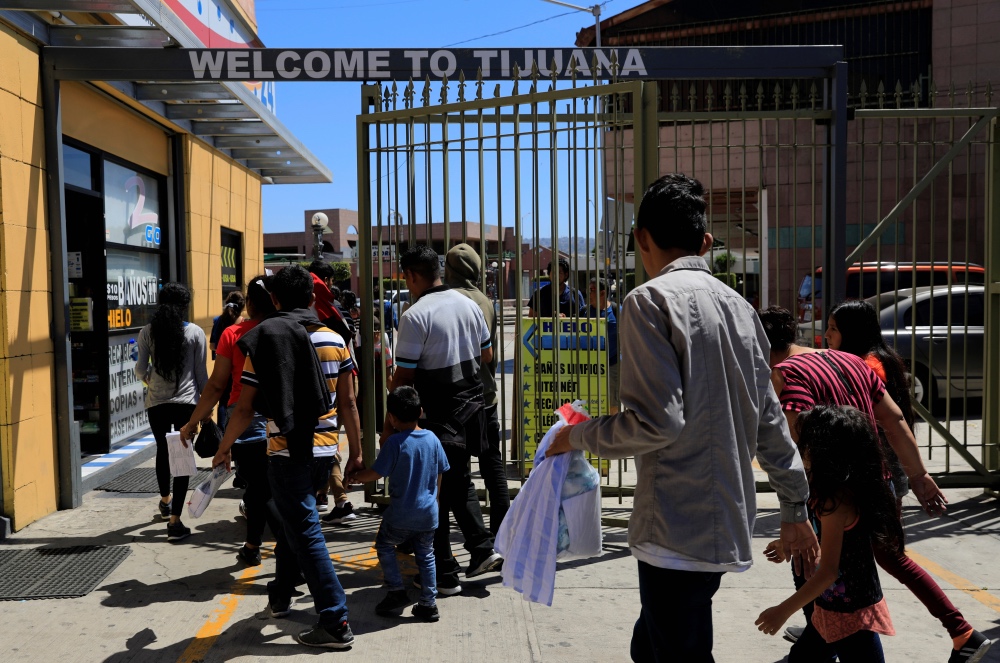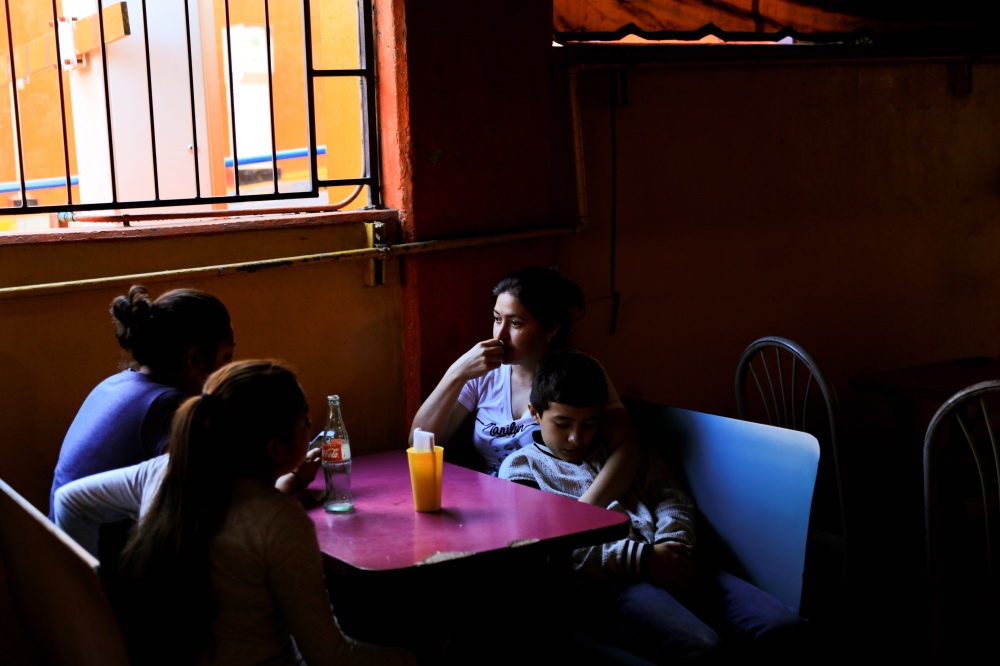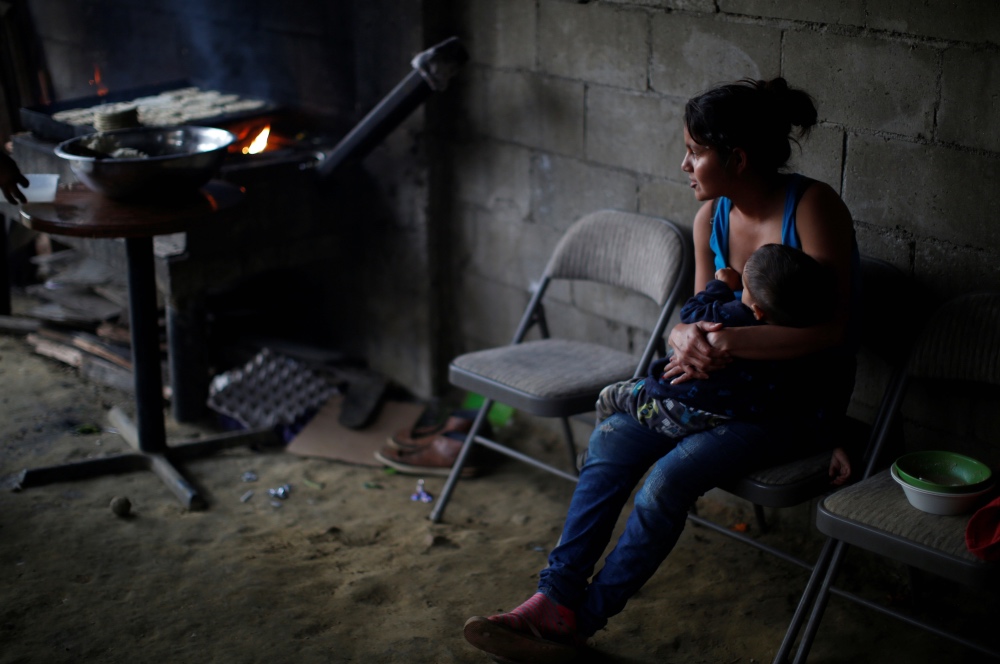
MICA ROSENBERG, KRISTINA COOKE and DANIEL TROTTA, of Reuters, report…
More than 2,000 Central American migrants seeking to settle in the United States have given up and accepted free rides home under a 10-month-old program funded by the US Government and run by a United Nations agency, according to a UN official.
The “Assisted Voluntary Return” program has paid for buses or flights for 2,170 migrants who either never reached the United States or were detained after crossing the border and then sent to Mexico to await US immigration hearings, according to Christopher Gascon, an official with the UN’s International Organization for Migration.

Central American migrants returned from the US to Mexico under the Migrant Protection Protocols, enter a shopping mall in Tijuana, Mexico, on 18th July. PICTURE: Reuters/Carlos Jasso
The $US1.65 million program, funded by the US State Department, is raising concerns among immigration advocates who say it could violate a principle under international law against returning asylum seekers to countries where they could face persecution.
The returned migrants have not been interviewed by US asylum officers. But Gascon said his agency screens all participants to ensure they are not seeking US asylum and want to go back.
“How can it be a voluntary decision [to return home] given the conditions they face in Mexico? It’s a choice between two hells.”
– Nicolas Palazzo, an attorney with El Paso-based Las Americas Immigrant Advocacy Center.
Gascon, head of the IOM’s Mexico mission, said the program provides a safer and more humane means of return than the migrants could arrange on their own.
The effort, whose scope and controversial aspects have not been previously reported, is the first by the State Department and UN to target Central American migrants in Mexico on such a large scale. The State Department would not comment on the record about its role.
Gascon said the State Department reached out to the IOM last year as caravans of thousands of Central American migrants travelled through Mexico towards the US border.
US President Donald Trump called the caravans an “invasion” and has made stemming immigration a centrepiece of his administration and 2020 re-election campaign.
Migrant advocates are particularly concerned about 347 people returned by the IOM who had been stuck in Mexico under a controversial Trump administration policy known as the Migrant Protection Protocols.
Under that policy, which began 29th January, some migrants who make it across the US-Mexico border are given a notice to appear in US immigration court, then are then turned back to Mexico to wait the months it can take for their court cases to be resolved. In the past seven months, more than 30,000 migrants have been sent back under MPP, according to US Customs and Border Protection.
Advocates say that the migrants often face danger and destitution in Mexican border towns, leaving them no good options.
“How can it be a voluntary decision [to return home] given the conditions they face in Mexico? It’s a choice between two hells,” said Nicolas Palazzo, an attorney with El Paso-based Las Americas Immigrant Advocacy Center.
Besides any danger they might face back home, there is another significant downside to leaving: If migrants do not show up for a US court hearing, they can be ordered deported “in absentia,” reducing their odds of ever being granted refuge in the United States.

Migrant from Honduras, Patricia Acosta, 36, embraces her son Adalberto Acosta, 13, as they finish eating at a restaurant after they were sent by the Customs and Border Protection to Mexico from the US under the Migrant Protection Protocols, in Tijuana, Mexico, on 21st July. Acosta’s husband and her youngest daughter managed to stay in the United States. “It was a family dream to cross and stay in the US so my kids could escape violence back in Honduras and get a better education,” Acosta said. “Now, I’m separated from the rest of my family and I’m stuck in a country that I don’t know anyone…In the cooler [detention centre] they treated us very cruelly, we didn’t have a place to go to the toilet…the verbal insults we received from the officers were horrendous.” PICTURE: Reuters/Carlos Jasso
Denia Carranza, a 24-year-old Honduran returned to Mexico to await a court hearing set for October, decided instead to board a bus back home last week.
She said she and her seven-year-old son had fled her hometown and a good job at a shrimp packing company after gang members threatened to kill her if she did not deal drugs to fellow employees. She had hoped to apply for US asylum.
But she said she was frightened in Ciudad Juarez – a battleground for drug cartels where the bulk of migrants await their hearings. Also, she had no job and no way to provide for her son.
“I am scared of going back to Honduras. But I am more afraid to stay,” she said.
“I am scared of going back to Honduras. But I am more afraid to stay.”
– Denia Carranza, a 24-year-old Honduran.
The US-based non-profit Human Rights First said it had documented more than 100 violent incidents perpetrated against migrants waiting in Mexico for US court hearings this year, including rape, kidnapping, robbery, assault and police extortion.
The IOM documented 247 deaths of migrants near the US-Mexico border this year through 15th August.
In a July 30 letter to the IOM’s Director General, 30 US and international advocacy organisations said they feared the UN organisation was returning migrants to countries they had fled “out of desperation, not choice, and where they may not fully understand the consequences of failing to appear whenever summoned by a US immigration court.”
There is no way of knowing how many of the migrants who opt to go home with IOM help might have been able to present a successful asylum claim. US courts ultimately deny most such claims brought by Central Americans and the Trump administration has said many are fraudulent.
Migrants who are sent to Mexico under MPP may or may not be seeking US asylum, but they generally have no opportunity to initiate such claims before being sent back across the border. The policy cuts out a traditional asylum screening step in which migrants are interviewed to establish whether they have a “credible fear” of returning home.

A migrant woman nurses her child inside a shelter in Tijuana, Mexico, on 22nd July. PICTURE: Reuters/Carlos Jasso
When the US State Department approached IOM last fall, Gascon said, part of the goal was to counter what is saw as misinformation about how easy it was to get into the United States.
IOM set up kiosks at a stadium in Mexico City, which was along the caravan route, and on the US-Mexico border. It also helped spread the word about free rides back in migrant shelters.
“When they saw the reality, some decided to go home,” he said of migrants.
Three quarters of the migrants in the voluntary return program went back to Honduras, a fifth to El Salvador and the rest to Guatemala and Nicaragua, according to IOM figures through 26th July of this year. More than half were “family units” and about 100 were unaccompanied minors. Most of the migrants have been sent back from Mexico, and a small fraction from Guatemala.
The IOM screens all migrants who ask to go home, but those awaiting US hearings in Mexico also undergo an orientation program with Grupo Beta, an arm of Mexico’s National Migration Institute, to ensure migrants understand their options, Gascon said.
So far, Gascon said, two people awaiting US court hearings in Mexico who wanted a ride back were instead referred to the Mexican government to gauge their eligibility for asylum in Mexico.
But advocates said they worried that Grupo Beta is not the best partner for IOM to ensure migrants’ safety.
“Many organisations have documented time and again that Mexican migration officials don’t refer people to [the national refugee office], they don’t register fears of return, and they have even pressured people to withdraw [asylum] claims,” said Kennji Kizuka, a researcher at the non-profit Human Rights First.
Mexican migration officials did not respond to a request for comment.
More than a dozen migrants awaiting US hearings at the Casa de Migrante shelter in Ciudad Juarez told Reuters the weekly south-bound bus rides held some appeal. Though reluctant to give up on their American dreams, many didn’t have lawyers and saw little prospect for success.
“All that effort we made to get here from Honduras and now we’re going back,” said Angel Estrada, who had hoped to get care in the United States for his nine-year-old son, who has hemophilia. “It’s really sad.”






